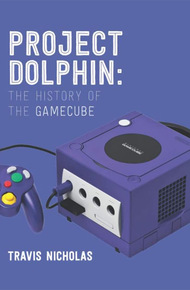
Travis is a long-time video game collector and has worked for various media outlets covering retro gaming and at the time current GameCube and Gameboy advance games.
The Nintendo GameCube has a long history starting with ideas that would be omitted from the N64 and a controller that would go on to be used for generations after it. Project Dolphin covers the complete history of the GameCube and its library of games released all over the world.
The GameCube was Nintendo's last traditional console. That allows it to occupy a unique place not only in Nintendo history, but in the history of the industry and our hobby. Each page of Travis Nicholas's encyclopedia of GameCube hardware, peripherals, and software is a brick in the memory lane you'll want to stroll down again and again. If you enjoy the mobi and epub versions, be sure to read the PDF to absorb the original formatting and artwork featuring in the book's hardcover publication. -David L. Craddock, curator
"I love this book! It offers a very thorough look at the gamecube, it's accessories, and gaming library. Although I don't always agree with the opinions mixed in with the facts regarding the games; I do appreciate them as they are well thought out counters to my own thoughts. I am no paper expert by any means, but the pages feel substantial and thick with a comfortable gloss and high quality. The images used are a beautiful compliment to the informative text. Whether you are looking to start a gamecube collection, a very worthy endeavor, or are simply interested in an informative nostalgic trip this book will serve you well."
– Amazon review"All information about GameCube products and games a must have if you're collecting for the GameCube. Am so happy."
– Amazon review"For fans of the GameCube or potential collectors of the system, Project Dolphin makes for an excellent addition to your library. With every game showcased along with practically every system and accessory, you are hard-pressed to find a more complete repository of GameCube information in one place."
– Game Tyrant reviewHistory of the Nintendo GameCube and How It Came To Be
November 27, 1998, marked the birth of the 128-bit era and the sixth generation of video game consoles. Coincidentally, this was also the day the Sega Dreamcast was released in Japan. The Nintendo 64 was only released in the US two years before had found itself in the unfamiliar territory of being in second place in the console war; at the end of 1998, the N64 had only shipped 15.22 million units worldwide as compared to the 11.5 million Sony PlayStation units shipped in the same year, followed by a total of 50 million units worldwide by March of the following year. The Sega Saturn came a distant third, with only around 10 million total units shipped worldwide. Owing to the high price of the cartridges and the lack of capacity to develop the games they wanted to develop, numerous third-party developers fled from Nintendo even before the launch of the N64.
"When we talk about Nintendo, we cannot ignore former president Hiroshi Yamauchi. He always said that if you have failures, you need to be to concerned. You always have good things and bad, and this reflects the history of Nintendo." - Satoru Iwata
Nintendo, never fearing failure, started working on their next console under utmost secrecy to improve upon what they learned from the N64 and what the rest of the industry was doing. In doing so, the R&D teams started working on what was dubbed the N2000 at the time and was later given the official title "Project Dolphin."
"If you do the same thing as others, it will wear you out. Nintendo is not good at competing, so we always have to challenge the status quo by making something new, rather than competing in an existing market." - Satoru Iwata
After the self-destruction of Silicon Graphics Inc.'s owing to in-fighting between the executives during the time of the N64, Nintendo started looking for a new partner to manufacture the graphics processors for their new system. Nintendo would look to many different companies before negotiating with CagEnt, formerly known as The 3DO Company Hardware group. After the failure of the 3DO system, the company sold the hardware unit to Samsung, which held patents of multiple technologies that utilized DVD playback in consoles. A lower version of their current chip, the M2, was used in the canceled follow up to the 3DO—the Panasonic M2. The chip was also used by Konami in their arcade boards.
